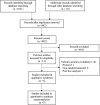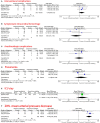General Anesthesia Versus Conscious Sedation for Intracranial Mechanical Thrombectomy: A Systematic Review and Meta-analysis of Randomized Clinical Trials
- PMID: 31181981
- PMCID: PMC6645641
- DOI: 10.1161/JAHA.118.011754
General Anesthesia Versus Conscious Sedation for Intracranial Mechanical Thrombectomy: A Systematic Review and Meta-analysis of Randomized Clinical Trials
Abstract
Background Endovascular therapy is the standard of care for severe acute ischemic stroke caused by large-vessel occlusion in the anterior circulation, but there is uncertainty regarding the optimal anesthetic approach during this therapy. Meta-analyses of observational studies suggest that general anesthesia increases morbidity and mortality compared with conscious sedation. We performed a systematic review and meta-analysis of randomized clinical trials to examine the effect of anesthetic strategy during endovascular treatment for acute ischemic stroke. Methods and Results Systematic review and meta-analysis according to PRISMA (Preferred Reporting Items for Systematic Reviews and Meta-Analyses) guidelines has been registered with the PROSPERO (International Prospective Register of Ongoing Systematic Reviews) ( CRD 42018103684). Medline, EMBASE, and CENTRAL databases were searched through August 1, 2018. Meta-analyses were conducted using a random-effects model to pool odds ratio with corresponding 95% CI . The primary outcome was 90-day functional independence (modified Rankin Scale 0-2). In the results, 3 trials with a total of 368 patients were selected. Among patients with ischemic stroke undergoing endovascular therapy, general anesthesia was significantly associated with higher odds of functional independence (odds ratio 1.87, 95% CI 1.15-3.03, I2=17%) and successful recanalization (odds ratio 1.94, 95% CI 1.13-3.3) compared with conscious sedation. However, general anesthesia was associated with a higher risk of 20% mean arterial pressure decrease (odds ratio 10.76, 95% CI 5.25-22.07). There were no significant differences in death, symptomatic intracranial hemorrhage, anesthesiologic complication, intensive care unit length of stay, pneumonia, and interventional complication. Conclusions Moderate-quality evidence suggests that general anesthesia results in significantly higher rates of functional independence than conscious sedation in patients with ischemic stroke undergoing endovascular therapy. Large randomized clinical trials are required to confirm the benefit.
Keywords: anesthesia; endovascular treatment; meta‐analysis; stroke.
Figures



Similar articles
-
Conscious sedation compared to general anesthesia for intracranial mechanical thrombectomy: A meta-analysis.Brain Behav. 2021 Jun;11(6):e02161. doi: 10.1002/brb3.2161. Epub 2021 May 7. Brain Behav. 2021. PMID: 33960706 Free PMC article. Review.
-
Anesthetic strategy during endovascular therapy: General anesthesia or conscious sedation? (GOLIATH - General or Local Anesthesia in Intra Arterial Therapy) A single-center randomized trial.Int J Stroke. 2016 Dec;11(9):1045-1052. doi: 10.1177/1747493016660103. Epub 2016 Jul 12. Int J Stroke. 2016. PMID: 27405859 Clinical Trial.
-
Effect of Conscious Sedation vs General Anesthesia on Early Neurological Improvement Among Patients With Ischemic Stroke Undergoing Endovascular Thrombectomy: A Randomized Clinical Trial.JAMA. 2016 Nov 15;316(19):1986-1996. doi: 10.1001/jama.2016.16623. JAMA. 2016. PMID: 27785516 Clinical Trial.
-
General Anesthesia may have Similar Outcomes with Conscious Sedation in Thrombectomy Patients with Acute Ischemic Stroke: A Real-World Registry in China.Eur Neurol. 2018;80(1-2):7-13. doi: 10.1159/000490901. Epub 2018 Jul 26. Eur Neurol. 2018. PMID: 30048983
-
Endovascular Mechanical Thrombectomy for Acute Ischemic Stroke Under General Anesthesia Versus Conscious Sedation: A Systematic Review and Meta-Analysis.World Neurosurg. 2018 Apr;112:e355-e367. doi: 10.1016/j.wneu.2018.01.049. Epub 2018 Jan 31. World Neurosurg. 2018. PMID: 29355808
Cited by
-
Mechanical thrombectomy in acute ischemic stroke due to large vessel occlusion in the anterior circulation and low baseline National Institute of Health Stroke Scale score: a multicenter retrospective matched analysis.Neurol Sci. 2022 May;43(5):3105-3112. doi: 10.1007/s10072-021-05771-5. Epub 2021 Nov 29. Neurol Sci. 2022. PMID: 34843020
-
Evidence-Based Updates to Thrombectomy: Targets, New Techniques, and Devices.Front Neurol. 2021 Sep 9;12:712527. doi: 10.3389/fneur.2021.712527. eCollection 2021. Front Neurol. 2021. PMID: 34566856 Free PMC article. Review.
-
Choosing Neuroanaesthesia as a career: Marching towards new horizons.Indian J Anaesth. 2021 Jan;65(1):35-42. doi: 10.4103/ija.IJA_1531_20. Epub 2021 Jan 20. Indian J Anaesth. 2021. PMID: 33767501 Free PMC article.
-
Pneumonia in Acute Ischemic Stroke Patients with Proximal Occlusions within the Anterior Circulation after Endovascular Therapy or Systemic Thrombolysis.J Clin Med. 2022 Jan 18;11(3):482. doi: 10.3390/jcm11030482. J Clin Med. 2022. PMID: 35159933 Free PMC article.
-
Association of local anesthesia versus conscious sedation with functional outcome of acute ischemic stroke patients undergoing embolectomy.Interv Neuroradiol. 2020 Aug;26(4):396-404. doi: 10.1177/1591019920923831. Epub 2020 May 6. Interv Neuroradiol. 2020. PMID: 32375517 Free PMC article.
References
-
- Badhiwala JH, Nassiri F, Alhazzani W, Selim MH, Farrokhyar F, Spears J, Kulkarni AV, Singh S, Alqahtani A, Rochwerg B, Alshahrani M, Murty NK, Alhazzani A, Yarascavitch B, Reddy K, Zaidat OO, Almenawer SA. Endovascular thrombectomy for acute ischemic stroke: a meta‐analysis. JAMA. 2015;314:1832–1843. - PubMed
-
- Goyal M, Menon BK, van Zwam WH, Dippel DW, Mitchell PJ, Demchuk AM, Davalos A, Majoie CB, van der Lugt A, de Miquel MA, Donnan GA, Roos YB, Bonafe A, Jahan R, Diener HC, van den Berg LA, Levy EI, Berkhemer OA, Pereira VM, Rempel J, Millan M, Davis SM, Roy D, Thornton J, Roman LS, Ribo M, Beumer D, Stouch B, Brown S, Campbell BC, van Oostenbrugge RJ, Saver JL, Hill MD, Jovin TG; Collaborators H . Endovascular thrombectomy after large‐vessel ischaemic stroke: a meta‐analysis of individual patient data from five randomised trials. Lancet. 2016;387:1723–1731. - PubMed
-
- Touma L, Filion KB, Sterling LH, Atallah R, Windle SB, Eisenberg MJ. Stent retrievers for the treatment of acute ischemic stroke: a systematic review and meta‐analysis of randomized clinical trials. JAMA Neurol. 2016;73:275–281. - PubMed
Publication types
MeSH terms
LinkOut - more resources
Full Text Sources
Medical

